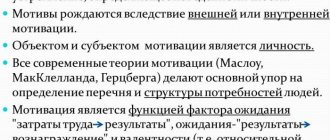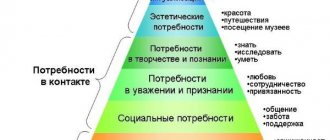In this article we will talk about theories of motivation and how to apply them at work.
Motivation is of great importance for business. Motivated employees perform better, are more productive and engaged. An important task of managers and HR managers is to create working conditions in which employees will feel motivated and effective.
Motivation and its benefits
Motivation comes from enjoying the work itself and the desire to achieve certain goals, such as earning more money or achieving a promotion.
In short, people's behavior is determined by what motivates them. Employee performance is the result of their abilities (such as skills and experience) and motivation. A talented employee who feels unmotivated is unlikely to perform well, while a motivated employee can often do much more than is expected of him.
In other words, employees have certain needs or desires and this causes them to do certain things (behaviors) that meet the needs (satisfaction), and this can then change which needs and desires are primary.
A well-motivated team can provide the following benefits:
- Better performance. This can lead to a reduction in the cost of the company's products, thereby allowing the organization to sell its product at a lower price and gain an advantage in the market.
- Lower absenteeism rates as employees are satisfied with their work life.
- Reduced staff turnover (the number of employees leaving the business). This can lead to lower training and recruitment costs.
- Satisfied employees give a company a good reputation as an employer, which makes it easier to find the best talent.
- Motivated employees can improve product quality and customer service.
What are the theories of motivation?
At a simple level, it seems obvious that people do things, such as going to work, to get what they want and avoid what they don't want. Why exactly they want what they do and don't want what they don't is still a mystery. It's a black box and it's not completely open yet.
In general, the basic view of motivation looks something like this:
There are several directions in theories of motivation:
- Content theories
- Process theories
Content theories focus on WHAT motivates, while process theories focus on HOW a person's behavior is motivated.
Content theories are the earliest theories of motivation. In the workplace they have had the greatest influence on management practice, while in academic circles they have been the least accepted. Content theories are also called need theories: they attempt to define our needs and link motivation to the satisfaction of those needs. Content theories cannot fully explain what motivates or demotivates us. Process theories are concerned with how motivation occurs and what process can influence our motivation.
Main content theories: Maslow's hierarchy of needs, McClelland's theory, Herzberg's two-factor theory and others.
Basic procedural theories: Skinner's theory, Vroom's theory, Adam's theory of justice, Locke's theory of goal setting and others.
No theory of motivation explains all aspects of people's motives, or lack thereof. However, each theoretical explanation can serve as a basis for the development of motivation techniques.











